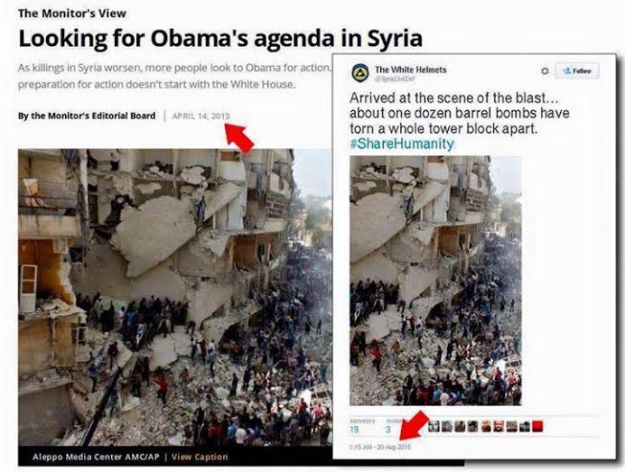Oct 01
20151
Avaaz, Foundations, Human Rights Watch, Non-Profit Industrial Complex, Purpose Inc., The International Campaign to Destabilize Syria, The Soros Network | OSI
The Propaganda war against Syria led by Avaaz & the White Helmets
October 1, 2015
by Vanessa Beeley
“Propaganda is the spreading of information in support of a cause. It’s not so important whether the information is true or false or if the cause is just or not — it’s all propaganda.
The word propaganda is often used in a negative sense, especially for politicians who make false claims to get elected or spread rumours to instigate regime change [my edit]. In fact, any campaign that is used to persuade can be called propaganda.”
Russia’s involvement in Syria has caused a flurry of “cold war”, Assad/ISIS co-dependency propaganda, all being produced by the usual suspects and all with the primary objective of invoking a No Fly Zone in Syria and stoking the “Russian Bear threat” fires that have been smouldering for some time.
I am going to attempt to dismantle this propaganda edifice one brick at a time.
Russia Attacks Moderate Rebels in Syria
In a Telegraph article dated 1st October 2015 with the headline British Troops Head to Saudi Arabia to train Syrian rebels it was stated:
American-led attempts to train up moderates to hold ground against Isil are months behind track because of the difficulty of finding groups which were not linked to the extremists.”
The term “moderate rebels” has become one of the most significant misnomers of this coming up to five year conflict. The hijacking of any semblance of a legitimate opposition to the Syrian Government by NATO, the US and regional allies including Israel in order to achieve their desired regime change has been well documented.
Who are these elusive “moderate rebels”? You may well ask. Traditionally it is the FSA that has been marketed as the cuddly, viable alternative to the Assad government which incidentally is the internationally recognised government of Syria, supported by the majority of the Syrian people. However we don’t have to dig too deep to reveal the hard line Islamist, Salafi affiliations of this so-called moderate group of brigands.
Journalist Daniel Greenfield puts it most succinctly: “Few media outlets are willing to say that out loud, but it’s quite true. There is no Free Syrian Army. It’s an umbrella for providing Western aid to a front group run by the Muslim Brotherhood.” He deplores the shaky Pentagon math that Obama and Congress have used in an attempt to downplay the reality that even in 2013 Pentagon sources were reluctantly admitting that extremist groups constituted over 50% of Syrian “opposition” and that these numbers were steadily increasing.
This map clearly shows the weakness of this “moderate rebel” argument as it unequivocally demonstrates the minor FSA presence at the frontline of Syrian opposition. They compose of fragmented mercenary groups largely unable to operate without extremist logistical support.
So this rather dispels the “moderate” myth and leads to the conclusion that in reality Russia was targeting areas north of Homs that contained few civilians and is an area controlled by a number of combined Muslim Brotherhood, Jihadist opposition fighters supported by the US alliance. It must also be remembered that the majority of civilians will flee an area infested by such mercenaries and seek refuge in government held areas. This is another fact conveniently omitted from most mainstream media reports. 90% of IDPs are in Government held areas.
It also makes a mockery of Defence Secretary Ashton B Carter’s claims in the New York Times yesterday:
“By supporting Assad and seemingly taking on everybody fighting Assad,” Defense Secretary Ashton B. Carter said Wednesday, Russia is “taking on the whole rest of the country that’s fighting Assad.” Some of those groups, he added, are supported by the United States and need to be part of a political resolution in Syria.
“That’s why the Russian position is doomed to fail,” Mr. Carter said.
Russia is effectively exposing US policy in Syria as naked hegemony and America is not happy. While the US has been supplying TOW missiles and a variety of arms/equipment to extremists and deliberately funding any group that will secure regime change, Russia is actively deploying its military to target the nests of terrorist mercenaries and opportunists waiting eagerly for the political vacuum that would be created by the “removal” of Assad, in order to inflict their extremism upon the Syrian people. They may not be technically called ISIS but they are cut from the same cloth of US/Israeli proxy terrorism and should be eliminated from any sovereign nation. Failure to do so has catastrophic results as seen in Libya and Iraq.
The Propaganda Trail
Now let’s examine the unsavoury marketing aspect of the propaganda campaign being waged by a frustrated and increasingly infuriated US alliance. Of course the usual triad has leapt into action. HRW, Avaaz and the White Helmets. Avaaz has produced one of its most poisonous and misleading petitions to date. The inevitable eyewitness statements claim that Russia targeted civilian areas utterly free of ISIS operatives. These statements are already rendered questionable by the evidence I have submitted above.
When we watch the videos, particularly the longer Liveleak version, it is hard to detect the women and children that are being described. The majority of protagonists appear to be male and of fighting age. There is no evidence of “civilian” life among the deserted buildings, the only movement is of males, some on foot, some on scooters and presumably some taking the time to film events even as the bombs are falling. Not the actions of terrified, innocent civilians.
Live Leak Video of Russian bombing of Homs
There is one other video that does show about 2 seconds of a young boy crying and obviously injured. However this video must be questioned as to its authenticity as the claims are that the initial shot of planes overhead is not even of Russian planes. The quality of the video is poor and apart from the footage of the one child, again demonstrates that the majority of people involved are men of fighting age in a deserted built up area to the north of Homs.
In this disgusting display of blatant propaganda calling for the long sought after no fly zone, Emma Ruby-Sachs, deputy director of Avaaz makes the extraordinary statement “Russia says it’s bombing ISIS, but eyewitnesses say their brutal attacks targeted areas way outside of ISIS control. This will only sow instability and radicalisation and should be an urgent wake-up call to the US and its allies to enforce a targeted no-fly zone to save lives, counter ISIS and alleviate the refugee crisis. Syrians civilians need protection now, not further attacks from Russian bombs.”
Speaking to one Damascus resident this morning, I asked for their opinion on this statement. His reply was simple, “I am just relieved that the Russian Air Force is in action”. The hypocrisy of this statement from Ruby-Sachs perfectly mirrors the hypocrisy of Congress, Obama’s Teflon speech at the UNGA, Pentagon’s barefaced obscurantism over the US role in creating exactly this instability and radicalisation in Syria and bringing misery, terror and bloodshed to the people of Syria with the sole aim of securing their interests in the region [and those of their staunchest partner in crimes against Humanity, Israel]
If we wish to speak of civilian casualties perhaps we should turn the spotlight on the pre- existing Coalition bombing campaign. The civilian death rates from these strikes is rarely discussed and often concealed by the Pentagon and US/European associated analysts like the SOHR. Where for example was the Avaaz petition calling for a No Fly Zone when the coalition air strikes resulted in a multitude of non-combatant deaths including children? This report from Airwars reveals the disturbing numbers:
“ Syria has also seen a number of troubling mass casualty events attributed to Coalition actions. On the first night of bombing on September 23rd 2014, US aircraft killed as many as 15 civilians in the village of Kafar Daryan. On December 28th at least 58 civilians reportedly died when the Coalition struck a temporary Daesh prison at al Bab (see report). And on April 30th 2015, 64 civilians died in a likely Coalition airstrike at Ber Mahli. In these three incidents alone, 106 non-combatant victims have so far been publicly named – 38 of them children. It remains unclear whether any of these events have been investigated by the Coalition.”
Syria’s civilians need a spanner putting in the spokes of this crushing propaganda vehicle that rides roughshod over their genuine needs with devastating consequences. Those needs are simple: stop lying, stop fabricating and stop creating, funding, arming and incubating the terrorist cancer in Syria.
The White Helmet element.
Now we come to perhaps one of the most insidious and damaging elements of the propaganda machine. The White Helmets, created by the Soros partnered, Svengali of PR giants, Purpose.com. The White Helmets with the debonair, Sandhurst educated James Bond of humanitarianism at its helm, James Le Mesurier, whose CV reads like a NATO regime change itinerary and whose connections delve deep into the Empire’s underworld of media manipulation and strategy cultivation.
The first slick photo campaign was hot off the press almost immediately after the first Russian air strikes in the Homs region:
Unfortunately for them, perhaps White Helmets are exhausting their supply of heart string tugging images as their twitter campaign almost immediately came under attack by those who are waking up to this cynical propagandization of human misery.
Quote from Sott.net ~ “The White Helmets in their haste to point the finger of blame at Moscow, managed to tweet about Russia’s air strikes several hours before the Russian Parliament actually authorized the use of the Air Force in Syria.”
This image was also picked up and run with by RT who accurately pinpointed the deep-rooted deceit that lies at the heart of the majority of White Helmet publicity campaigns. The flurry of activity on the White Helmet twitter page must have taken, even them, by surprise. For so long they have enjoyed the fruits of their marketing campaign depicting them as selfless heroes, saviours of humanity, impartial protectors of kittens and Syrians in equal measure. Unarmed, neutral, demi-saints climbing the “Mount Everest of war zones”. Unfortunately so many of their masks have slipped that they can no longer bask in their Purpose reflected glory.
Yesterday like HRW before them they were exposed to be the fabricators and deceivers they really are. Anyone can make a mistake I hear you say, yes sure, one mistake is acceptable, 2 is questionable but a consistent conveyer belt of misleading, perception altering, “nudging” images ceases to be innocent and enters the realm of manipulation on a terrifying scale with horrifying ramifications for the people of Syria who so far, have resisted their country being plunged into the same abyss as Libya or Iraq.
Just one other example of the White Helmet duplicitous image use:
Another image was brought to my attention this morning that further shatters the high gloss White Helmet image. Whilst it is well known that far from being neutral, the White Helmets are in fact embedded with Al Nusra [the Syrian arm of Al Qaeda], it is perhaps not so well known that their southern Damascus depot is situated at the heart of ISIS held territory, to the south of the notorious Palestinian Yarmouk refugee camp. This image shows their insignia and emblem clearly on the wall and gates behind the selfie taking ISIS mercenary in the foreground. It is becoming harder and harder for White Helmets to maintain their veneer of impartiality, a fact that is borne out quite effectively by the fact that the majority of Syrians in government held areas have never heard of them, even unbiased civilians in Aleppo have not come across them. Their association is exclusively with the extremist elements of the Syrian opposition. Their purpose is to facilitate calls for a No Fly Zone, cue Avaaz, and destabilize the region in the manner demanded by their masters in the US, UK and Syrian National Council.
Conclusion
We can safely conclude that the US, Israel and their allies are furious that they have been out manoeuvred and outsmarted by Russia and Syria. Their No Fly Zone plans have been consistently thwarted and derailed. Russia has effectively demanded a US coalition No Fly Zone which is the ultimate insult to US hegemony and self-proclaimed world police status. Russia, unlike the US IS targeting ISIS in all its distorted guises and nomenclature. And yes Mr Defence Secretary, Russia is bombing US supported “rebels” in Syria for the very simple reason, the US has funded all extremist factions in Syria since they first started down the blood strewn road of regime change.
If we lived in a just world we would see Avaaz and their ilk clamouring for an end to interventionism and demanding diplomatic solutions to support internal, sovereign nation, peace processes [as in fact Russia has unwaveringly called for in Syria]. However we do not live in a world based upon a universal understanding of justice, we live in a world governed by the powerful and the greedy, devoid of compassion, intent only on their geopolitical prowess and humanity exempt colonialism. For the sake of the Syrian people and all other nations being crushed by this well used, well-oiled propaganda machine we must question, we must demand answers, and we must wake up to our responsibility to reject calls for the destruction of nations and peoples who ask only for their basic human right to determine their own futures.
Avaaz, HRW, White Helmets and their associates have no place in that brave new world.






































































